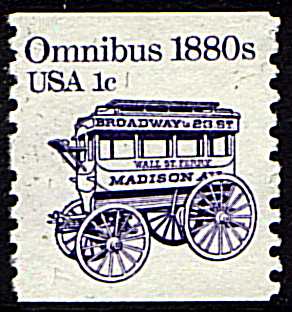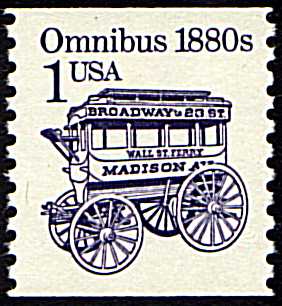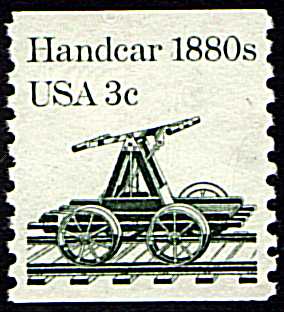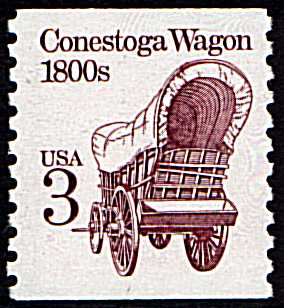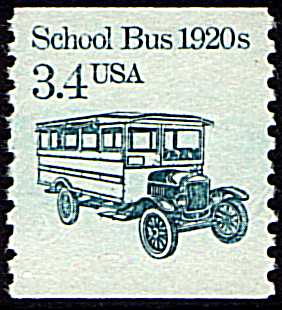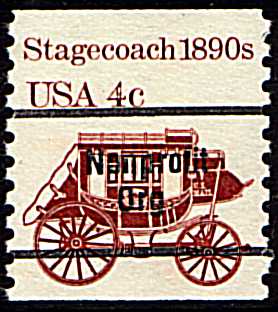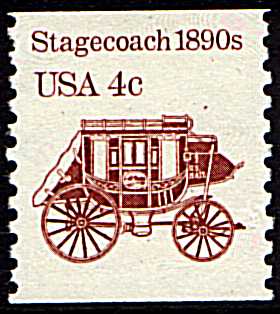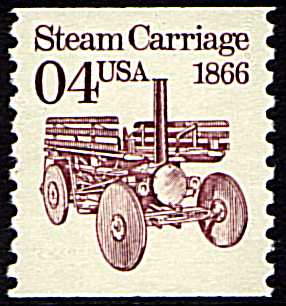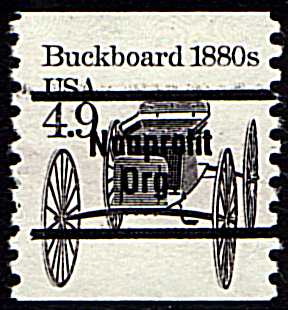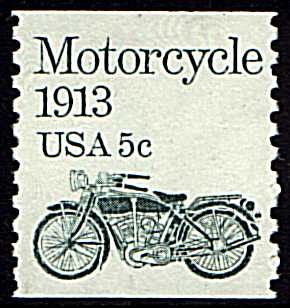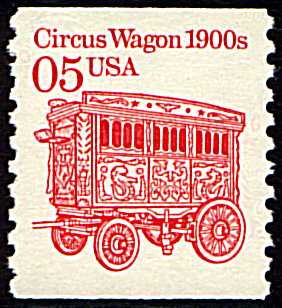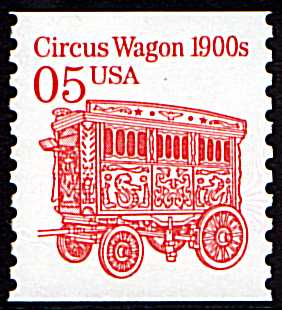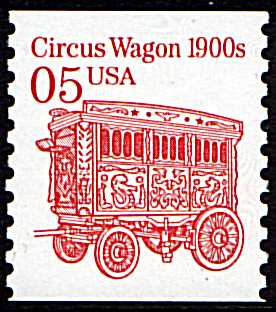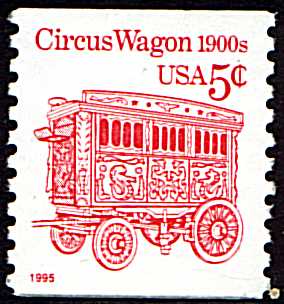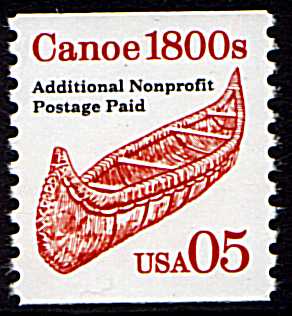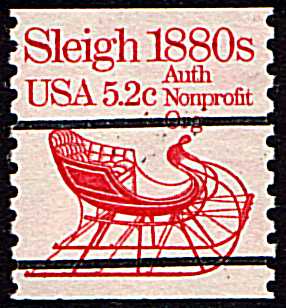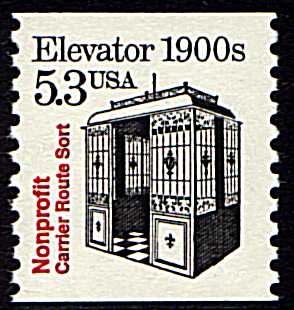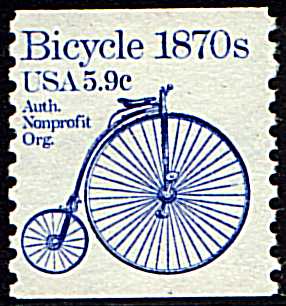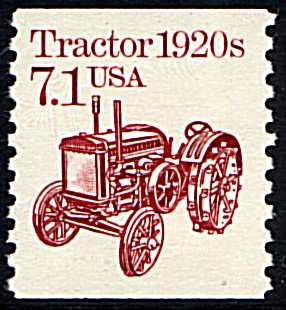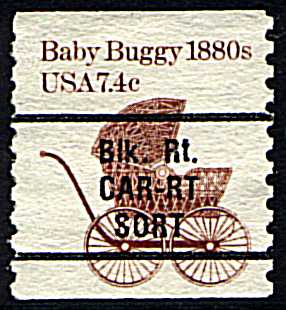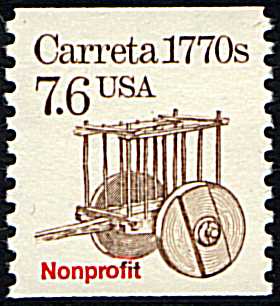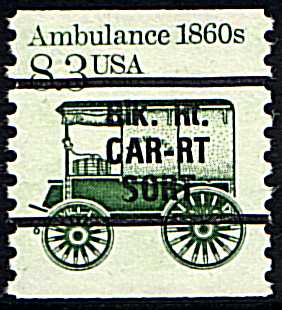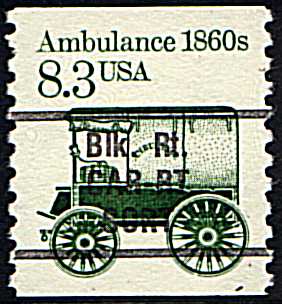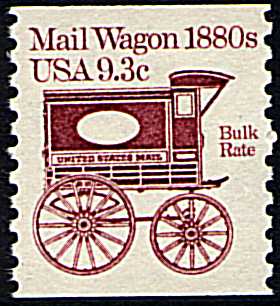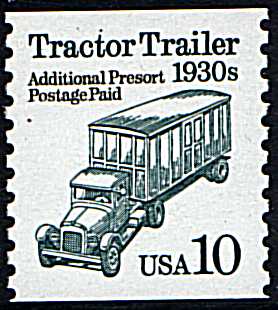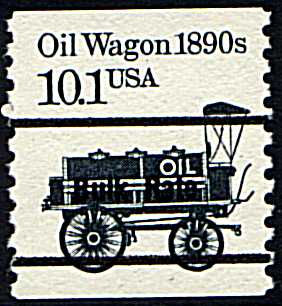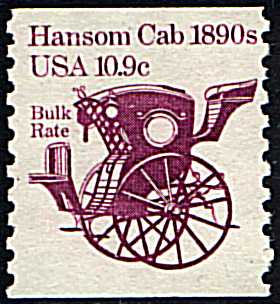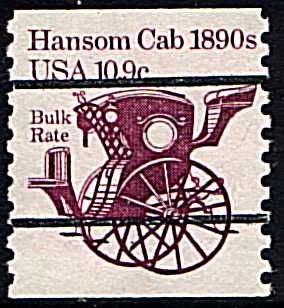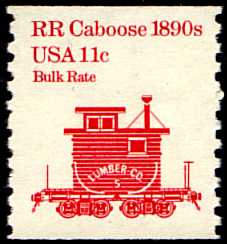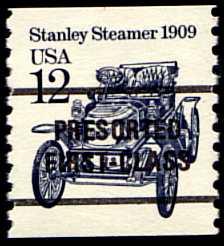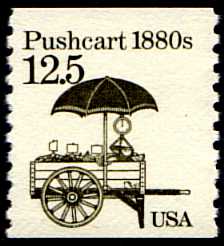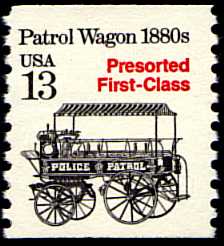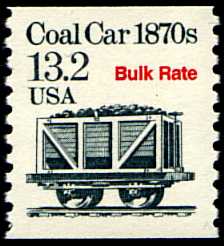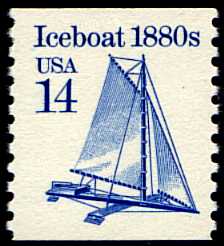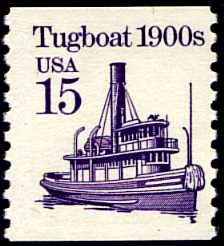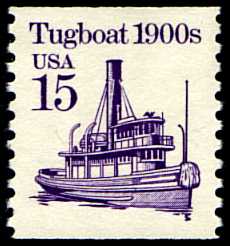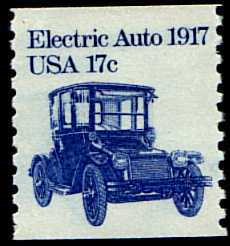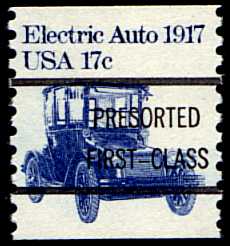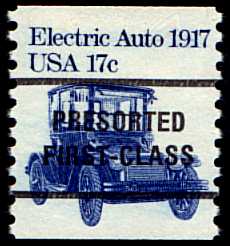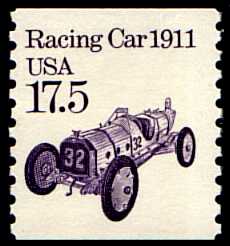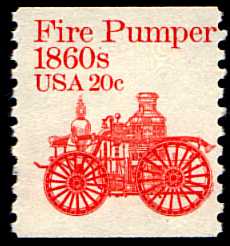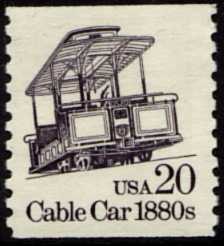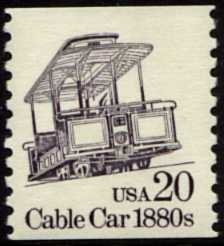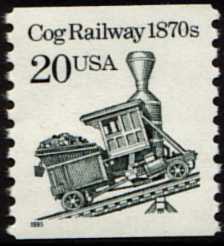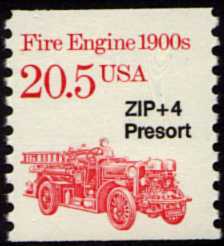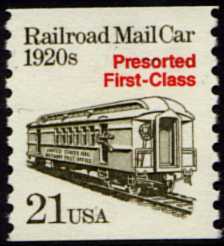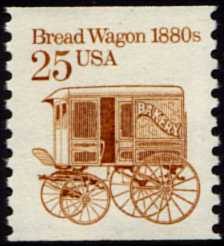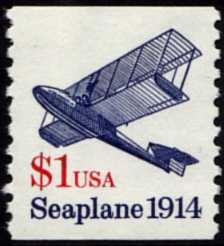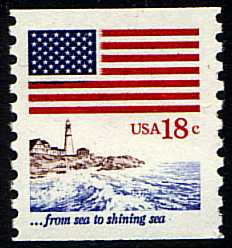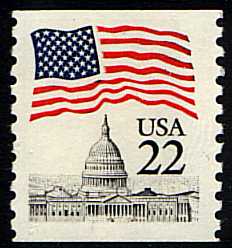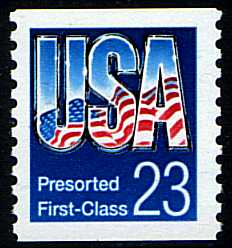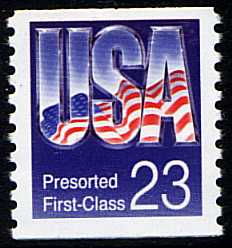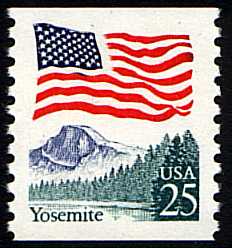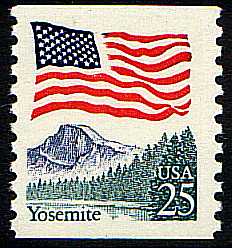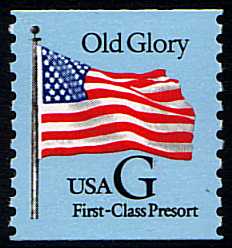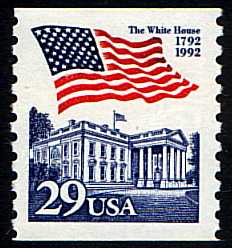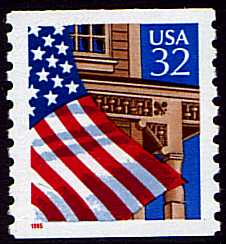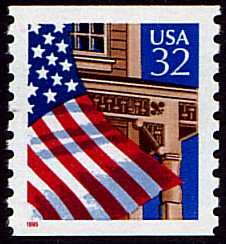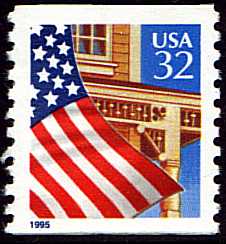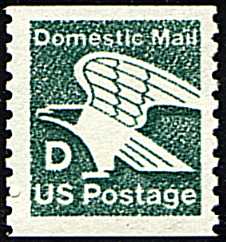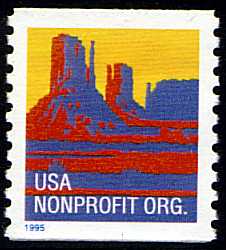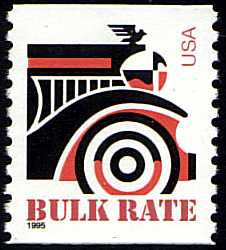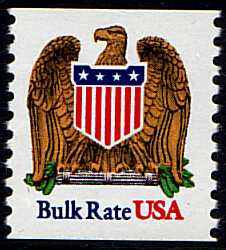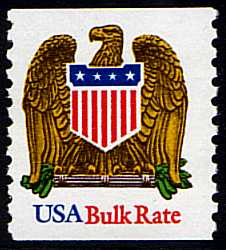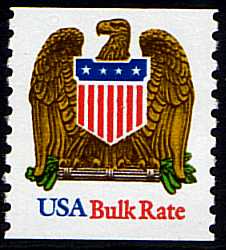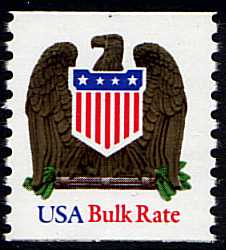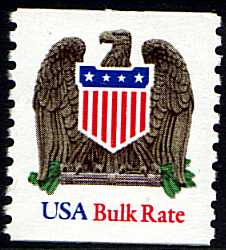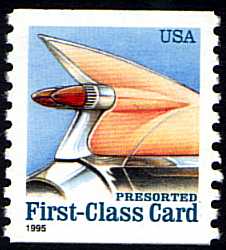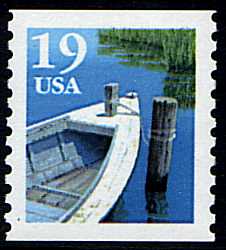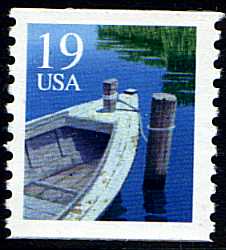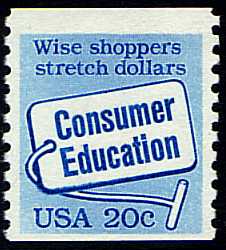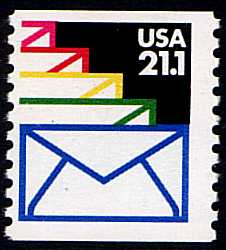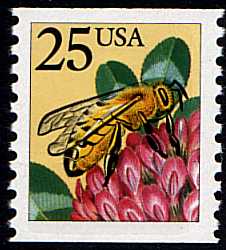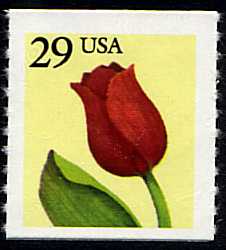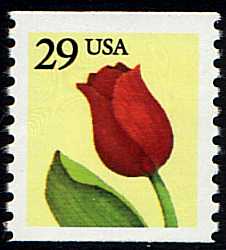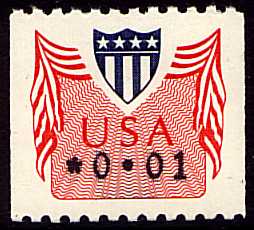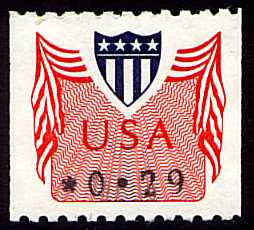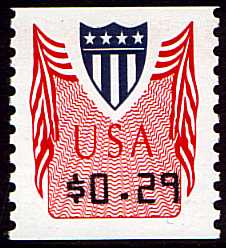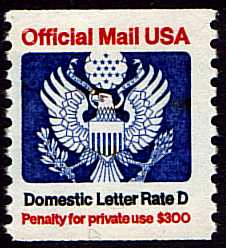

| Home | P is for Plate Number Coil <<< | Contents | >>> Q is for Quality | Credits |
P is for Plate Number Coil
Below is my table (sorted by general type, then by denomination) of all the PNC's through January, 1996. For my page explaining what PNC's are, and how to collect them go here. This table is very cryptic, in an effort to condense as much as possible into the smallest space. The Terms and Abbreviations at the bottom of this page should help.
This table was published originally in the September, 1996 issue of The American Philatelist,
with whose permission I am reproducing it here. The original title was "Collecting Plate Number Coils".
Click on any Scott number to bring up an image of that stamp.
Note that many of the images look the same, since the distinction between them is
the tagging (or lack thereof), which is visible only under UV light;
or the gum, which is visible only from the back;
or some subtle design variation detectable only with precise measurements.
Denom. |
Design and PC/SI |
Year |
Plate |
Key |
|||||
|
Transportation Series |
|||||||||
|
1¢ |
Omnibus I |
1983 |
Cott. |
0'all |
Dull |
1-6 |
(small "1¢") |
.40 |
|
" |
II |
1986 |
B |
Block |
Dull |
1,2 |
(large "1") |
.55 |
|
" |
II |
1990 |
B/C |
None |
Dull |
2,3 |
(large "1") |
.60 |
|
2¢ |
Locomotive I |
1982 |
Cott. |
0'all |
Dull |
2-4,6,8,10 |
(small "2¢") |
.50 |
|
" |
II |
1987 |
B |
Block |
Dull |
1 |
(large "2") |
.60 |
|
" |
II |
1994 |
C/D |
None |
Dull |
2 |
(large "2") |
.70 |
|
3¢ |
Handcar |
1983 |
Cott. |
0'all |
Dull |
1-4 |
.65 |
|
|
3¢ |
Conestoga |
1988 |
B |
Block |
Dull |
1 |
.90 |
|
|
" |
" |
1991 |
C/D |
None |
Dull |
2,3 |
1.00 |
|
|
" |
" |
1995 |
C/D |
None |
Shiny |
3 |
1.00 |
|
|
3.4¢ |
School Bus |
1985 |
Cott. |
0'all |
Dull |
1,2 |
.90 |
|
|
" |
1985 |
Cott. |
None |
Dull |
1,2 |
5.00 |
||
|
4¢ |
Stagecoach I |
1982 |
Cott. |
0'all |
Dull |
1-6 |
(letters 19½ mm) |
.90 |
|
" |
I PC |
1982 |
Cott. |
None |
Dull |
3-6 |
(letters 19½ mm) |
6.00 |
|
" |
II |
1986 |
B |
Block |
Dull |
1 |
(letters 18 mm) |
1.00 |
|
" |
II |
1990 |
B |
0'all |
Dull |
1 |
(letters 18 mm) |
12.50 |
|
4¢ |
Steam Carriage |
1991 |
C/D |
0'all |
Dull |
1 |
1.00 |
|
|
" |
" |
1991 |
C/D |
None |
Dull |
1 |
1.10 |
|
|
4.9¢ |
Buckboard |
1985 |
Cott. |
0'all |
Dull |
3,4 |
.90 |
|
|
" |
PC |
1985 |
Cott. |
None |
Dull |
1-6 |
1.40 |
|
|
5¢ |
Motorcycle |
1983 |
Cott. |
0'all |
Dull |
1-4 |
1.00 |
|
|
5¢ |
Milk Wagon |
1987 |
B |
Block |
Dull |
1 |
1.10 |
|
|
5¢ |
Circus Wagon I |
1990 |
B |
0'all |
Dull |
1 |
(yellow paper) |
1.50 |
|
" |
I |
1991 |
B |
None |
Dull |
1 |
(yellow paper) |
1.45 |
|
" |
II |
1992 |
Grav. |
None |
LG |
A1,A2 |
(white paper) |
1.50 |
|
" |
II |
1994 |
Grav. |
None |
LG |
A3 |
(ink glows under UV) |
1.50 |
|
" |
III |
1995 |
Grav. |
None |
LG |
S1 |
("5¢") |
1.50 |
|
5¢ |
Canoe I SI |
1991 |
C |
None |
Dull |
1-3 |
(brown ink) |
1.50 |
|
" |
II SI |
1991 |
Grav. |
None |
Shiny |
S11 |
(orange ink) |
1.20 |
|
" |
II SI |
1993 |
Grav. |
None |
LG |
S11 |
(orange ink) |
1.80 |
|
5.2¢ |
Sleigh SI |
1983 |
Cott. |
0'all |
Dull |
1-3, 5 |
8.50 |
|
|
" |
SI+PC |
1983 |
Cott. |
None |
Dull |
1-6 |
12.00 |
|
|
5.3¢ |
Elevator SI |
1988 |
B |
None |
Dull |
1 |
1.00 |
|
|
5.5¢ |
Star Route Truck |
1986 |
B |
Block |
Dull |
1 |
1.60 |
|
|
" |
SI |
1986 |
B |
None |
Dull |
1,2 |
1.50 |
|
|
5.9¢ |
Bicycle SI |
1982 |
Cott. |
0'all |
Dull |
3,4 |
15.00 |
|
|
" |
SI+PC |
1982 |
Cott. |
None |
Dull |
3-6 |
25.00 |
|
|
6¢ |
Tricycle |
1985 |
B |
Block |
Dull |
1 |
1.10 |
|
|
" |
PC |
1985 |
B |
None |
Dull |
1,2 |
1.30 |
|
|
7.1¢ |
Tractor |
1987 |
B |
Block |
Dull |
1 |
2.00 |
|
|
" |
SI-a |
1987 |
B |
None |
Dull |
1 |
(nonprofit) |
3.00 |
|
" |
SI-b |
1989 |
B |
None |
Dull |
1 |
(5-digit + 4) |
1.60 |
|
7.4¢ |
Baby Buggy |
1984 |
B |
Block |
Dull |
2 |
8.50 |
|
|
" |
PC |
1984 |
B |
None |
Dull |
2 |
3.50 |
|
|
7.6¢ |
Carreta SI |
1988 |
B |
None |
Dull |
1-3 |
1.75 |
|
|
8.3¢ |
Ambulance I |
1985 |
Cott. |
0'all |
Dull |
1,2 |
(letters 18½ mm) |
1.25 |
|
" |
I PC |
1985 |
Cott. |
None |
Dull |
1-4 |
(letters 18½ mm) |
1.35 |
|
" |
II PC |
1986 |
B |
None |
Dull |
1,2 |
(letters 18 mm) |
3.00 |
|
8.4¢ |
Wheel Chair SI |
1988 |
B/C |
None |
Dull |
1-3 |
1.80 |
|
|
8.5¢ |
Tow Truck |
1987 |
B |
Block |
Dull |
1 |
2.60 |
|
|
" |
SI |
1987 |
B |
None |
Dull |
1,2 |
2.60 |
|
|
9.3¢ |
Mail Wagon SI |
1981 |
Cott. |
0'all |
Dull |
1-6 |
carmine rose |
12.50 |
|
" |
SI |
1981 |
Cott. |
0'all |
Dull |
3,4 |
brownish rose |
30.00 |
|
" |
SI+PC |
1981 |
Cott. |
None |
Dull |
1-6, 8 |
carmine rose |
14.50 |
|
" |
SI+PC |
1981 |
Cott. |
None |
Dull |
3,4 |
brownish rose |
25.00 |
|
10¢ |
Canal Boat |
1987 |
B |
Block |
Dull |
1 |
1.50 |
|
|
" |
" |
1992 |
B |
0'all |
Dull |
1 |
4.25 |
|
|
" |
" |
1993 |
B/C/D |
EP |
Shiny |
1,2 |
3.00 |
|
|
10¢ |
Tractor Trailer I SI |
1991 |
C/D |
None |
Dull |
1 |
(yellow paper) |
1.75 |
|
" |
II SI |
1994 |
Grav. |
None |
LG |
11,22 |
(white paper) |
2.00 |
|
10.1¢ |
Oil Wagon |
1985 |
B |
Block |
Dull |
1 |
2.25 |
|
|
" |
PC |
1985 |
B |
None |
Dull |
1,2 |
2.25 |
|
|
" |
SI |
1988 |
B |
None |
Dull |
2,3 |
2.00 |
|
|
10.9¢ |
Hansom Cab SI |
1982 |
Cott. |
0'all |
Dull |
1,2 |
28.00 |
|
|
" |
SI+PC |
1982 |
Cott. |
None |
Dull |
1-4 |
27.00 |
|
|
11¢ |
Railroad Caboose SI |
1984 |
B |
Block |
Dull |
1 |
4.00 |
|
|
" |
SI+PC |
1984 |
B |
None |
Dull |
1 |
3.00 |
|
|
" |
SI |
1991 |
C/D |
None |
Dull |
2 |
2.00 |
|
|
11¢ |
Stutz Bearcat |
1985 |
Cott. |
0'all |
Dull |
1-4 |
1.40 |
|
|
12¢ |
Stanley Steamer I |
1985 |
Cott. |
0'all |
Dull |
1,2 |
(letters 18 mm) |
1.75 |
|
" |
I PC |
1985 |
Cott. |
None |
Dull |
1,2 |
(letters 18 mm) |
1.75 |
|
" |
II PC |
1987 |
B |
None |
Dull |
1 |
(letters 17½ mm) |
19.00 |
|
12.5¢ |
Pushcart |
1985 |
B |
Block |
Dull |
1,2 |
2.65 |
|
|
" |
PC |
1985 |
B |
None |
Dull |
1,2 |
2.70 |
|
|
13¢ |
Patrol Wagon SI |
1988 |
B |
None |
Dull |
1 |
2.45 |
|
|
13.2¢ |
Coal Car SI |
1988 |
B |
None |
Dull |
1,2 |
2.45 |
|
|
14¢ |
Iceboat I |
1985 |
Cott. |
0'all |
Dull |
1-4 |
(letters 18 mm) |
2.25 |
|
" |
II |
1986 |
B |
Block |
Dull |
2 |
(letters 17½ mm) |
3.30 |
|
15¢ |
Tugboat |
1988 |
B |
Block |
Dull |
1,2 |
1.80 |
|
|
" |
" |
1990 |
B |
0'all |
Dull |
2 |
2.90 |
|
|
16.7¢ |
Popcorn Wagon SI |
1988 |
B |
None |
Dull |
1,2 |
2.50 |
|
|
17¢ |
Electric Auto |
1981 |
Cott. |
0'all |
Dull |
1-7 |
2.00 |
|
|
" |
PC-A |
1981 |
Cott. |
None |
Dull |
3-7 |
("Presorted" 11.3 mm) |
2.10 |
|
" |
PC-B |
1981 |
Cott. |
None |
Dull |
3-6 |
("Presorted" 12.8 mm) |
15.00 |
|
" |
PC-C |
1981 |
Cott. |
None |
Dull |
1-5, 7 |
("Presorted" 13.4 mm) |
18.50 |
|
17¢ |
Dog Sled |
1986 |
B |
Block |
Dull |
2 |
3.00 |
|
|
17.5¢ |
Racing Car |
1987 |
B |
Block |
Dull |
1 |
3.00 |
|
|
" |
SI |
1987 |
B |
None |
Dull |
1 |
3.10 |
|
|
18¢ |
Surrey |
1981 |
Cott. |
0'all |
Dull |
1-18 |
3.00 |
|
|
20¢ |
Fire Pumper |
1981 |
Cott. |
0'all |
Dull |
1-16 |
2.50 |
|
|
20¢ |
Cable Car |
1988 |
C/D |
Block I |
Dull |
1,2 |
(Tagging 20.5 x 23.5 mm |
2.60 |
|
" |
" |
1988 |
C/D |
Block 11 |
Dull |
2 |
(Tagging 19 x 22 mm) |
2.60 |
|
" |
" |
1990 |
C/D |
0'all |
Dull |
2 |
4.00 |
|
|
20¢ |
Cog Railway |
1995 |
C |
EP |
Shiny |
1,2 |
3.00 |
|
|
20.5¢ |
Fire Engine SI |
1988 |
B |
None |
Dull |
1 |
3.00 |
|
|
21¢ |
RR Mail Car SI |
1988 |
B/C |
None |
Dull |
1,2 |
3.00 |
|
|
23¢ |
Lunch Wagon |
1991 |
C |
SP |
Dull |
2,3 |
3.50 |
|
|
" |
" |
1992 |
C |
EP |
Dull |
3 |
4.00 |
|
|
" |
" |
1993 |
C |
EP |
Shiny |
3 |
4.00 |
|
|
24.1¢ |
Tandem Bike SI |
1988 |
B |
None |
Dull |
1 |
3.50 |
|
|
25¢ |
Bread Wagon |
1986 |
B |
Block |
Dull |
1,5 |
(reddish) |
3.50 |
|
" |
" |
1988 |
C/D |
Block |
Dull |
2-4 |
(yellowish) |
3.20 |
|
32¢ |
Ferry Boat |
1995 |
C |
EP |
Shiny |
2-5 |
5.00 |
|
|
$1 |
Seaplane |
1990 |
B |
0'all |
Dull |
1 |
8.00 |
|
|
" |
" |
1993 |
C/D |
EP |
Shiny |
3 |
8.00 |
|
|
Flag Issues |
|||||||||
|
(5¢) |
"G" Flag SI |
1995 |
Grav. |
None |
LG |
A11111,A21111 |
(Nonprofit Presort) |
1.00 |
|
18¢ |
Flag and lighthouse |
1981 |
B |
Block |
Shiny |
1-7 |
4.25 |
|
|
20¢ |
Flag & Supreme Court |
1981 |
B |
Block I |
Shiny |
1-3,5,11, 13,14 |
(large block) |
4.25 |
|
" |
" |
1981 |
C |
Block II |
Shiny |
4,6,8-10,12 |
(small block) |
4.25 |
|
" |
PC |
1984 |
B |
None |
Shiny |
14 |
55.00 |
|
|
22¢ |
Flag & Capitol |
1985 |
B |
Block I |
Shiny |
2,4,6,10, 13-16,21 |
(large) |
3.00 |
|
" |
" |
1985 |
C/D |
Block II |
Shiny |
1,3,5,7, 8,11,12 ,17-20,22 |
(small) |
3.00 |
|
" |
" |
1987 |
C |
SP |
Shiny |
T1 |
3.00 |
|
|
23¢ |
Flag Presort |
1991 |
Grav. |
None |
LG |
Axxx (6) |
3.50 |
|
|
23¢ |
USA I SI |
1992 |
Grav. |
None |
LG |
Axxxx (9) |
(ABNC, "23" = 6 mm tall) |
4.00 |
|
" |
II SI |
1992 |
Grav. |
None |
Shiny |
1111 |
(BEP, letters = 16½ mm) |
4.00 |
|
" |
II SI |
1994 |
Grav. |
None |
LG |
1111 |
4.00 |
|
|
" |
III SI |
1993 |
Grav. |
None |
LG |
S111 |
(SVS, letters = 15½ mm) |
4.50 |
|
25¢ |
Flag & Yosemite |
1988 |
B |
Block I |
Shiny |
1-3 |
(large block) |
3.25 |
|
" |
" |
1988 |
C/D |
Block 11 |
Shiny |
4,5, 7-9 |
(small block) |
3.25 |
|
" |
" |
1989 |
C/D |
EP |
Shiny |
1-3,5-11, 13-15 |
3.50 |
|
|
(25¢) |
"G" Flag SI |
1995 |
Grav. |
SP |
LG |
S11111 |
(1st Class Presort) |
4.50 |
|
29¢ |
Flag & Mt. Rushmore I |
1991 |
C/D |
EP |
Shiny |
1-9 |
(BEP) |
4.50 |
|
" |
II |
1991 |
Grav. |
EP |
LG |
A11111,A22211 |
(ABNC) |
4.25 |
|
29¢ |
Flag & White House |
1992 |
C/D/F |
EP |
Shiny |
1-16, 18 |
5.00 |
|
|
(32¢) |
"G" I |
1995 |
Grav. |
EP |
Shiny |
1111,2222 |
(BEP, black "G") |
5.00 |
|
" |
II |
1995 |
Grav. |
EP |
LG |
Axxxx (36) |
(ABNC, blue "G") |
5.00 |
|
" |
III |
1995 |
Grav. |
EP |
Shiny |
S11111 |
(SVS, red "G" perfed) |
5.00 |
|
" |
III |
1995 |
Grav. |
EP |
Shiny |
S2222 |
(SVS, rouletted) |
5.00 |
|
32¢ |
Flag over Porch I |
1995 |
Grav. |
SP |
LG |
xxxxx (5) |
(BEP, red date) |
5.00 |
|
" |
I |
1995 |
Grav. |
SP |
Shiny |
11111 |
(BEP, red date) |
5.00 |
|
" |
II |
1995 |
Grav. |
SP |
LG |
S11111 |
(SVS, black date) |
5.00 |
Interested in Flags On Stamps?Collector Bob Hunt has started a study group for that topic - email him at "bh1861@att.net" and tell him you want to join. OR visit his web site to learn more. And don't miss Flags on Stamps by Richard Mallett. |
|||||||||
|
Contingency Issues |
|||||||||
|
(22¢) |
"D" Eagle |
1985 |
Grav. |
Block |
Dull |
12 |
6.00 |
|
|
(25¢) |
"E" Earth |
1988 |
Andr. |
Block |
Dull |
1111,1211, 1222,2222 |
2.50 |
|
|
(29¢) |
"F" Flower |
1991 |
Grav. |
SP |
Shiny |
1111,1211,1222, 2211,2222 |
3.75 |
|
(see Flag Issues, above) |
(various) |
"G" Old Glory |
1995 |
||||||
|
Miscellaneous Issues |
|||||||||
|
(5¢) |
Butte SI |
1995 |
Grav. |
None |
LG |
S111 |
(SVS) |
1.00 |
|
(10¢) |
Auto SI |
1995 |
Grav. |
None |
LG |
S111 |
(SVS) |
1.80 |
|
(10¢) |
Eagle & Shield I SI |
1991 |
Grav. |
None |
LG |
Axxxxx (42) |
(ABNC, "USA" red) |
2.60 |
|
" |
II SI |
1993 |
Grav. |
None |
Shiny |
xxxx (6) |
(BEP, "USA" blue) |
3.10 |
|
" |
II SI |
1993 |
Grav. |
SP |
Shiny |
22221,22222 |
(BEP, error) |
25.00 |
|
" |
II SI |
1993 |
Grav. |
None |
LG |
22222 |
(BEP) |
3.10 |
|
" |
III SI |
1993 |
Grav. |
None |
LG |
S11111 |
(SVS, metallic gold) |
3.50 |
|
" |
III SI |
1995 |
Grav. |
None |
LG |
S22222 |
(SVS, green fluoresces) |
3.50 |
|
15¢ |
Cadillac Tailfin I SI |
1995 |
Grav. |
None |
LG |
11111 |
(BEP, blue date) |
2.25 |
|
" |
II SI |
1995 |
Grav. |
None |
LG |
S11111 |
(SVS, black date) |
2.25 |
|
18¢ |
Washington |
1985 |
Andr. |
Block |
LG |
1112,3333 |
3.00 |
|
|
" |
SI |
1985 |
Andr. |
None |
LG |
11121,33333 |
6.50 |
|
|
" |
SI |
1985 |
Andr. |
None |
Dull |
33333,43444 |
7.00 |
|
|
19¢ |
Fishing Boat I |
1991 |
Grav. |
SP |
LG |
Axxxx (4) |
(ABNC, jagged "1") |
3.00 |
|
" |
II |
1993 |
Grav. |
SP |
LG |
Axxxx (7) |
(ABNC, smooth "1") |
3.50 |
|
" |
II |
1993 |
Grav. |
None |
LG |
A5555 |
(ABNC, smooth "1") |
10.50 |
|
" |
III |
1994 |
Grav. |
SP |
LG |
S11 |
(SVS, 1 rope loop) |
4.25 |
|
20¢ |
Consumer Education |
1982 |
Cott. |
0'all |
Dull |
1-4 |
100.00 |
|
|
21.1¢ |
Letters |
1985 |
Andr. |
Block |
LG |
11111,11121 |
3.50 |
|
|
" |
SI |
1985 |
Andr. |
None |
LG |
11111,11121 |
3.75 |
|
|
25¢ |
Honeybee |
1988 |
(Mix) |
Block |
Shiny |
1,2 |
3.00 |
|
|
25¢ |
Juke Box I SI |
1995 |
Grav. |
None |
LG |
111111 |
(BEP, blue date) |
4.00 |
|
" |
II SI |
1995 |
Grav. |
None |
LG |
S11111 |
(SVS, black date) |
4.00 |
|
29¢ |
Flower (rouletted) |
1991 |
Grav. |
SP |
Shiny |
S1111,S2222 |
4.25 |
|
|
29¢ |
Flower (perf I0) |
1992 |
Grav. |
SP |
Shiny |
S2222 |
4.00 |
|
|
Computer-Vended Postage |
|||||||||
|
" |
Variable Denomination I |
1992 |
C/D |
SP |
Dull |
1 |
(BEP) |
8.00 |
|
" |
Variable Denomination I |
1992 |
C/D |
EP |
Shiny |
1 |
7.50 |
|
|
" |
Variable Denomination II |
1994 |
Grav. |
EP |
LG |
A11 |
(ABNC) |
5.75 |
|
" |
Variable Denomination III |
1996 |
Grav. |
EP |
LG |
11 |
BEP |
? |
|
Officials |
|||||||||
|
20¢ |
Official |
1983 |
B |
Block |
Shiny |
1 |
60.00 |
|
|
(22¢) |
"D" Official |
1985 |
B |
Block |
Shiny |
1 |
70.00 |
|
Terms and Abbreviations
Scott No. - Most of the stamps are numbered as listed in the Scott U.S. Specialized Catalogue. In a few cases, I make distinctions that Scott does not, or to which it assigns no unique number or letter, in which case I add "v" (for variety) to the Scott number.
Gum types - I have tried to use the latest terms, sorting gums into three types ? dull, low gloss (LG), and shiny. In most cases, these terms are unambiguous, and you should have no trouble determining the gum type on an individual stamp. A stamp with dull gum, for example, often looks as though it has no gum at all. The gum has no sheen, little or no stickiness, and feels rough. Shiny gum is just that ? very smooth, very shiny (it reflects a bright light source clearly), and sticky to the touch if there is the least moisture on your fingers. Low gloss gum is somewhere between the other two. It feels smooth and has a slight sheen and some stickiness (it will take fingerprints, for example), but it is quite clearly neither dull nor shiny. In a few instances, however,the terms are relative and make sense only when you have seen examples. Of the four recent 32- cent "G" coils, for example, the BEP version (black "G") clearly has shiny gum, and the ABNC version (blue"G") clearly has low gloss gum. The two printed by SVS (red "G") lie somewhere in between low gloss and shiny and even differ slightly from each other. I have called them shiny, but minus the ABNC version, I might have gone with low gloss.
Precancel (PC) - Any overprint added after printing (a practice no longer in use), such as black bars, even if it includes text such as "PRESORTED FIRST CLASS," I have designated a precancel (PC).
Service Inscription (SI) - I have used this term only when the design of the stamp includes some text indicating its intended use (ZIP+4 or Presorted First-Class, for example), and that inscription was printed with the rest of the design.
Presses - Most of these stamps were printed at the Bureau of Engraving and
Printing (the BEP), where production equipment and methods have been extensively studied
and documented by staff and collectors. The names used are the ones listed in the
reference works on my other PNCs page. The presses are as
follows:
Cott. = Cottrell press - single-color
intaglio presses (4 of them) at the BEP. The method of printing, with two plates
fastened together to form the printing cylinder, created joint lines on the stamps, with
a line and plate number every 24 stamps. The last Cottrell was retired in 1985.
B = B press at BEP, Giori single-
station three-color intaglio press with a single seamless printing cylinder, hence no
joint lines. Plate numbers occur once every 52 stamps. Dismantled in 1993.
C = C press at BEP, Goebel single-
station three-color intaglio press, single seamless cylinder, plate number every 48
stamps.
D = D press at BEP, Goebel multi-
station combination offset-intaglio press, with an intaglio station identical to that of
the C press, hence a plate number every 48 stamps.
F = F press at BEP, Goebel multi-
station combination offset-intaglio press, with an intaglio station identical to that of
the C press, hence a plate number every 48 stamps.
Grav. = generic term, Gravure press,
mostly non-BEP, or nothing more specific available
Andr. = Andreotti multi-station multi-
color gravure press at BEP, producing a set of plate numbers (one per color) either every
24 or every 38 stamps.
(Mix) = more than one press was needed
to produce the stamp (BEP)
Tagging - First, a definition:
"Tagging" is the addition of a phosporescent substance, as a coating, or as a part of the paper, to make a stamp visible under the ultraviolet light (UV) used in USPS automated cancelling and sorting machines. It was first used on U.S. stamps on an experimental basis in 1963, and by 1974 was standard on all first-class stamps. Lower value stamps are generally NOT tagged, so that they cannot be used to fool the machines.
I use seven designations for tagging types ? None, O'all, Block,
Block I, Block II, SP, and EP. Their meanings are as follows:
1. None: Just that, totally untagged. All precancels are untagged, except by
error. Service-inscribed stamps have no tagging, unless they are philatelic issues of
stamps issued originally with precancels. Finally, low-value definitives issued since
1990 are untagged, in an effort to prevent their use as a way of underpaying postage.
2. O'all: Overall tagging. This refers to tagging that is applied to the entire
surface of the stamp after the design has been printed. It is usually smooth and even in
tone and texture, and may obscure the stamp design when activated (under UV light). If
you have difficulty recognizing the differences among overall, embedded phosphor (EP),and
surface phosphor (SP) tagging, compare known examples of each and develop your own set of
rules for differentiating. In most cases, it should not be difficult.
3. Block: This refers to a rectangle of taggant applied last in the printing
process on top of the design. It usually is centered on the stamp, leaving an untagged
border on all sides. (While the total absence of tagging on a stamp not regularly issued
that way may increase its value, variations in the centering of the block tagging do
not.) The size of the rectangle varies from one issue to another, however, and sometimes
even on the same issue (see Block I and Block II). The block tagging on the 11-cent
Railroad Caboose stamp is unusual in that it carries the design of the 20-cent Flag over
Supreme Court coil. This came about because the Caboose coil was tagged specially for
philatelic sale, using tagging mats that had been used on the other stamp,
and had worn down to the shape of its design.
4. Block 1: Larger of two block tagging styles on the same issue. There are four
instances, three of them on flag issues, related to the press on which the issue was
printed (B or C), since the tagging is applied by a station of the press, more or less as
an integral part of the printing process. Of the fourth instance, on the 20-cent Cable
Car, which was printed on the C and D presses, I have seen no explanation. I assume the
two come from different printings and different tagging mats.
5. Block II: Smaller of the two block tagging styles on the same issue. See Block
1.
6. SP: Surface phosphor is a variety of tagging where the phosphor is added as a
last step in the paper-making process, as a coating. It is generally smooth and even,
like overall tagging, but usually less bright. Since the taggant is applied before the
printing process, and the design is on top of it, it should not interfere with the design
when activated.
7. EP: Embedded phosphor is a variety of tagging where the phosphor is actually a
part of the coating on the paper (not of the paper itself ? it is not visible from the
back). It usually is rather mottled in appearance, which is the chief method of
distinguishing it from surface phosphor tagging. Like surface phosphor, it lies under the
stamp design.
Printers - From 1894 until the 1980's, almost all U.S. stamps were printed at the
Bureau of Printing and Engraving (BEP), the government bureau that prints all our money.
In the past 20 years, more and more of the stamp printing has gone to private firms, as
the need to economize has forced the USPS to look at other printers. If no printer is
stated in the Key Features column, it was the BEP.
BEP - Bureau of Engraving and Printing
SVS - Stamp Venturers - a loose
partnership of printing companies formed specifically for the purpose of printing stamps
for the USPS. The printing company used varies according to the needs of the stamp.
ABNC - Guilford Gravure for
American Bank Note Company
Retail Price - This was the Scott U.S. Specialized Catalog price for the cheapest 5-stamp plate number strip of the item in January of 1996 (scarcer plate number bring higher prices). Some prices are higher now.
The above table was originally published in the September, 1996 issue of The American Philatelist, with whose permission I am reproducing it here. The original title was "Collecting Plate Number Coils".
If you are interested in stamp collecting, and not yet a member of The American Philatelic Society, I recommend you join - my own membership has increased the value and enjoyment of my stamp collecting activities immeasurably. Click on their logo above to visit the main page of their web site and learn more.
| Home | P is for Plate Number Coil <<< | Contents | >>> Q is for Quality | Credits |
Send feedback to the webmaster: CLICK HERE
Revised -- 04/07/2008
